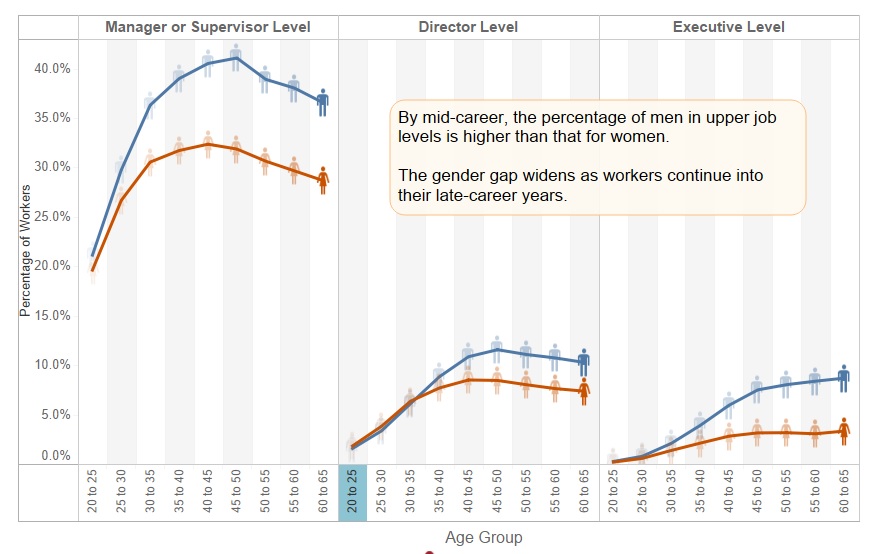Gender pay data can be examined in a number of different ways, but no matter how you slice it, the pay gap still exists.
The most recent research by compensation data and software company PayScale, where I work, shows that the pay gap between men and women has shrunk. This “uncontrolled pay gap,” or the median salary for all men compared to the median salary all women — regardless of job, experience or worker seniority — shows that women made 76 cents for every dollar earned by men in 2016. So, women earned slightly more last year when compared to 74 cents for every dollar earned by men in 2015.
That’s somewhat encouraging news, but a difference in pay of 24% between genders is still staggering. However, it doesn’t give us a complete picture. Things look better when we make an apples-to-apples comparison, controlling for compensable factors such as years of experience, specific skills and job title. When we look at this “controlled pay gap,” which compares men and women’s pay for the same job with the same qualifications, women today make about 98 cents for every dollar earned by men (up from 97 cents last year).
Clearly, this is a much better number for women, but the problem is that even a few cents add up. For a man making $150,000 a year, this gap means a woman will earn $3,000 less annually for doing the same job.
The opportunity gap
 When we dig even deeper into this data we see that men aren’t just getting paid more, they are also being promoted into higher paying leadership positions more frequently than their female counterparts. In fact, men are 85% more likely than women to hold executive-level positions by mid-career and they are almost twice as likely to hold these senior positions in their late careers. This massive “opportunity gap” resulting from promotion velocity represents a huge pay gap for women over time.
When we dig even deeper into this data we see that men aren’t just getting paid more, they are also being promoted into higher paying leadership positions more frequently than their female counterparts. In fact, men are 85% more likely than women to hold executive-level positions by mid-career and they are almost twice as likely to hold these senior positions in their late careers. This massive “opportunity gap” resulting from promotion velocity represents a huge pay gap for women over time.
If a company doesn’t address the pay or opportunity gap, it can impact their ability to retain talent, truly engage employees and – ultimately – maximize profits. PayScale’s research shows that employees want to work at organizations where corporate values such as fairness are aligned with their own personal values, so gender inequity takes a toll on all employees, not just women
What can you do to address these issues at your company? Here are three specific steps HR departments and managers can take:
1. Be a champion for pay fairness
Gender pay inequity can creep in unconsciously when left unchecked. If employers don’t think proactively about pay equity, they risk unintentionally paying men and women differently over time. Be sure to use market data to price jobs and define pay bands for all positions at the company, then ensure both men and women fall within these bands. If there are some employees who fall outside the established pay bands, investigate why their salary is either too high or too low and take action to bring it into alignment, if necessary.
Our research shows there’s a chasm between employees’ and employers’ perceptions of fair pay. For example, 57% of employers say that their organization has no issue with gender inequity, so no action is needed. However, only 48% of employees agree with them. Market data and a well-defined compensation program can be effective to ensure that pay is fair and reflects that current talent market.
2. Address any opportunity gaps that exist
The data shows that women are less likely than men to have higher paying executive-level jobs. Look at your executive team and other leadership groups at your organization: are men and women equally represented? If not, why? There are some industries that tend to have more gender disparity at the highest levels than others. If you see that women are not climbing the corporate ladder at the same rate as men, look for ways to overcome this disparity. Research shows that companies with diverse leadership teams are more profitable in the long run.
3. Talk openly with employees about pay
There is a sea change underway when it comes to talking about pay. Compensation used to be taboo and was shrouded in secrecy. Now, many top performing companies welcome discussions about pay because it opens the door to having a conversation that builds more trusting relationships with employees. Employers don’t need to necessarily post every employee salary for all to see in order to establish pay transparency and fairness-in-pay practices. Rather, they can share the data used to define salaries and show pay grades for every position which allows employees where they fit on the spectrum.
Having more open conversations can be hard (and even scary) for managers. Employers need to train these managers how to talk effectively about pay and provide them with real market data to use in conversations with their employees.
There are many facets to the gender pay gap which must be explored to really understand the impact on not only women, but on our overall workplace culture. Employers can take steps to ensure all employees are paid fairly and feel valued. But proactively addressing the gender pay and opportunity gap at your company doesn’t just make people feel better; it’s also good for the bottom line.
